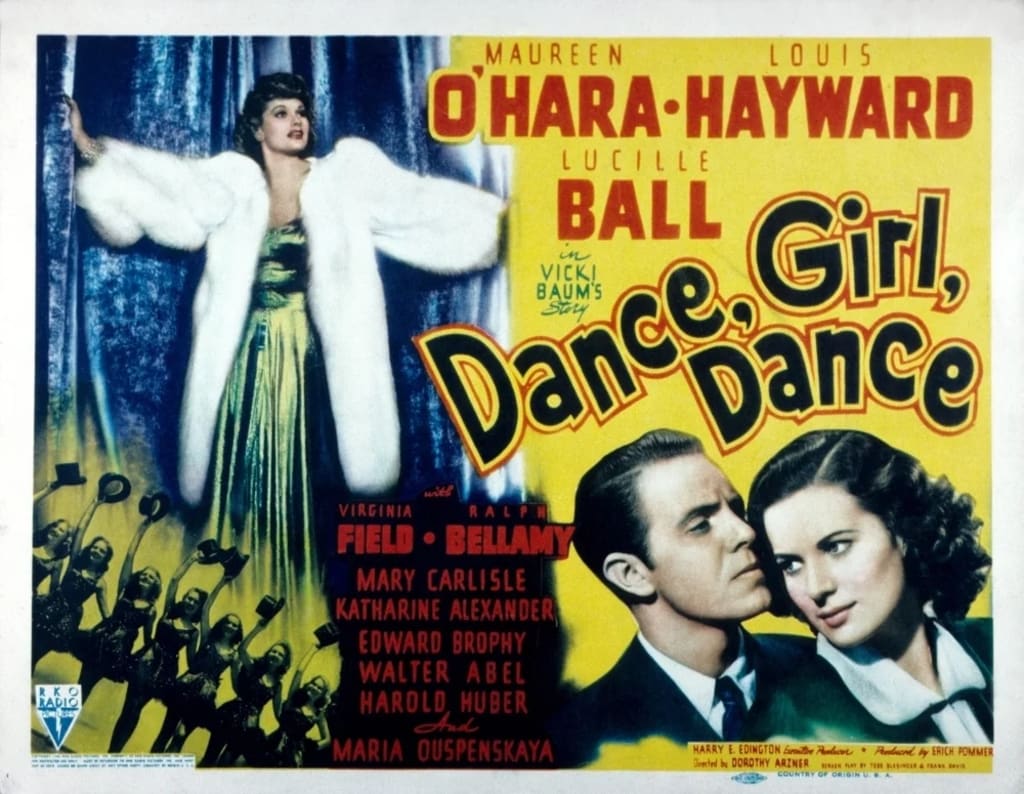Dance, Girl, Dance (1940)
Why I wanted to love this film, but didn’t…

“Hey, Rachel,” the 1970’s feminists in my head say, “If you want to be an imaginary 1940’s screen writer you have to watch Dorothy Arzner’s Dance, Girl, Dance”. I don’t want to disappoint the sisterhood, so I dutifully watch the film.

I don’t like writing negatively about films. If I see a film that I don’t like, or that didn’t move me I just let it pass me by. I write about the films I think other people might enjoy. (Although I have been known to have a rant about movies that I think are actively damaging or shady in their story-telling). Making a movie is an achievement. The odds are stacked against any film being made. And creativity and originality is a tough ask in a system that is primarily concerned with making money. I don’t want my mean words out there, denigrating any one’s effort.
So, I wasn’t going to write about Dance, Girl, Dance (1940).

But then I guess the people involved are all now dead, so I’m not going to hurt them. Not more than this contemporary review:
“Dance, Girl, Dance is just a cliché-ridden, garbled repetition of the story of the aches and pains in a dancer’s rise to fame and fortune. It is a long involved tale told by a man who stutters… Nevertheless it is Miss Ball who brings an occasional zest into the film, especially in that appearance in the burlesque temple where she stripteases the Hays office. But it isn’t art.” (Bosley Crowther in the New York Times)
Ouch. Those are some mean words. But I sort of agree.

The plot details: A band of dancers are struggling to make a living. One of them is a star, Bubbles (played by Lucille Ball). One of them believes she is an artiste, Judy (played by Maureen O’Hara).
When Bubbles gets a job in Burlesque, she employs her old friend Judy as her stooge – the straight gal to her funny, sexy character. It is an act of friendship – albeit a friendship that is fraught and complicated by differing values. There is a romantic sub-plot about a divorced guy still in love with his ex-wife courting both women. But it is the professional rivalry between Bubbles and Judy that is key.
The film shows dancing as a means of self-expression and creativity, but also a money maker.

The film was not a critical nor a commercial success when it was released. But it underwent a critical feminist re-evaluation in the 1970s. Two reasons for this.
The first is Dorothy Arzner. Arzner was the first and only female member of the Directors Guild of America in 1940. This makes her a significant historical figure. In pictures of her at work she is slicked back hair and the jodhpurs and boot combination of her male counterpoints like de Mille and Griffith. She was as openly gay as the time permitted, living with her partner, the choreographer, Marion Morgan. Her singularity points to how women in Hollywood can be both side-lined and pioneers.

The second is the speech given by Judy when she turns on the jeering men of the burlesque audience:
“I know you want me to tear my clothes off so you can look at your fifty cents worth. Fifty cents for the privilege of staring at a girl the way your wives won’t let you! What do you suppose we think of you up here and your silly smirks your mothers would be ashamed of? We know it’s the thing of the moment for the dress suits to come and laugh at us too. We laugh right back at the lot of you, only we’re paid to let you sit there and roll your eyes and make your screamingly clever remarks. What’s it for? So as you can go home when the show’s over and strut before your wives and sweethearts and play at being the stronger sex for a minute? I’m sure they see through you just like we do.”
This speech matters. It breaks out from the screen and forces the audience to think about what they are watching and why. So, alongside retrieving Dorothy Arzner from obscurity, this speech was why feminist film theorists Pam Cook, Claire Johnstone and Judith Mayne re-appraised the film. That speech foreshadows much of the debate about women on film and male voyeurism. It is a discussion of power and empowerment. It questions the idea of male entitlement and women’s subordination. It hints at something more complex and knowing.
And this is why I wanted to love the film.
After all the BFI website describes Dance, Girl, Dance as one of Arzner’s “detailed, complex and affectionate studies of female companionship often rich in homoerotic overtones” and who wouldn’t want to watch that?.
So, why does it feel lacklustre in ways that Stage Door or It Happened One Night doesn’t? Why does it feel stilted? What is missing?

The movie was initially to be directed Roy Del Ruth, an experienced musical director. But he struggled to find the story. Arzner had limited musical experience, but she did know how to put complicated women on screen. It was her decision to make the film about “The Art Spirit” versus “The Go-Getter”.
Arzner had things to say – mainly that the pursuit of heterosexual relationships can twist the friendships between women which should be nourishing and creative.
It’s worthy. But it’s not necessarily exciting. It’s like nutritious brown rice, when you want chocolate fudge cake.
Dance, Girl, Dance disappoints despite the sparkle of Lucille Ball. Maybe this is because Arzner as the only representative of “female director” had to put the message before taking risks on screen. She has to be professional before innovative. It’s hard to take chances, when you shouldn’t really be there.
As Katherine Hepburn said in a telegram to Arzner for her Directors Guild of American tribute in 1975:
“Isn’t it wonderful that you’ve had such a great career when you had no right to a career at all.”

So, Dorothy, thank you for the story – but as an imaginary 1940s screen writer I want the razzle-dazzle as well as the morality. If a film is called Dance, Girl, Dance I want multiple high-kicks rippling across a wide-screen. I want flashbacks and layered narratives and spinning screens and high camp and beautiful gowns and hats and cigarettes and jeopardy and plot twists and a smoking gun.
Ah well, looks like I’m going to have to write it myself.
If you've enjoyed what you have read, consider subscribing to my writing on Vocal. If you'd like to support my writing, you can do so by leaving a one-time tip. Thank you.
About the Creator
Rachel Robbins
Writer-Performer based in the North of England. A joyous, flawed mess.
Please read my stories and enjoy. And if you can, please leave a tip. Money raised will be used towards funding a one-woman story-telling, comedy show.






Comments (1)
Another good read from my fave imaginary 40s hack...uh... screenwriter!